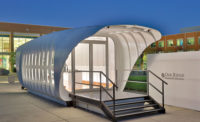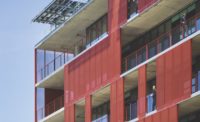The U.S. Army, in conjunction with private industry, is involved in a multiyear research project that could yield stronger, lighter, and longer-span structures, for both civil and military applications. The research is examining the benefits of adding vanadium to steel.


Vanadium is an element distributed widely through a variety of minerals. But in the U.S., it is primarily recovered from by-products of chemical and petroleum processing. The addition of a small amount to steel, from 0.03 to 0.10 percent, “can have a dramatic effect on properties,” says Bob Glowdowski, director of technical services for Pittsburgh-based vanadium supplier Stratcor.
Since mid 2005, engineering firm Simpson Gumpertz & Heger (SGH) has been studying the potential of vanadium-based high-strength steel for long-span roof structures, examining weld integrity, the optimal size of components, and strength, with physical tests and simulation. So far, results indicate that the vanadium-based alloy has a yield strength of up to 80 kips per square inch (ksi), compared to 50 ksi for conventional structural steel, according to Ron Mayes, a SGH staff consultant in San Francisco. The firm is slated to complete a detailed report this summer and will then work with the army to design a full-scale demonstration project.
The army’s vanadium research has not been limited to buildings. Other partners are working to produce lighter, and therefore more fuel-efficient, military vehicles. Also, they hope to reduce the weight of anything transported by truck or plane, such as temporary bridge structures, explains Charleston, South Carolina–based Polly Graham, Vanadium Technology Partnership program manager.
Project participants say that the project should yield environmental benefits since vanadium-based steel components are as readily recyclable as those made of more common steel alloys but provide the same load-bearing capacity with 25 percent less material. Economic benefits are also expected. However, these savings are unlikely to be proportional to the weight savings, says Mayes, since the raw material only accounts for about one third of the price of a finished structural component.




Post a comment to this article
Report Abusive Comment